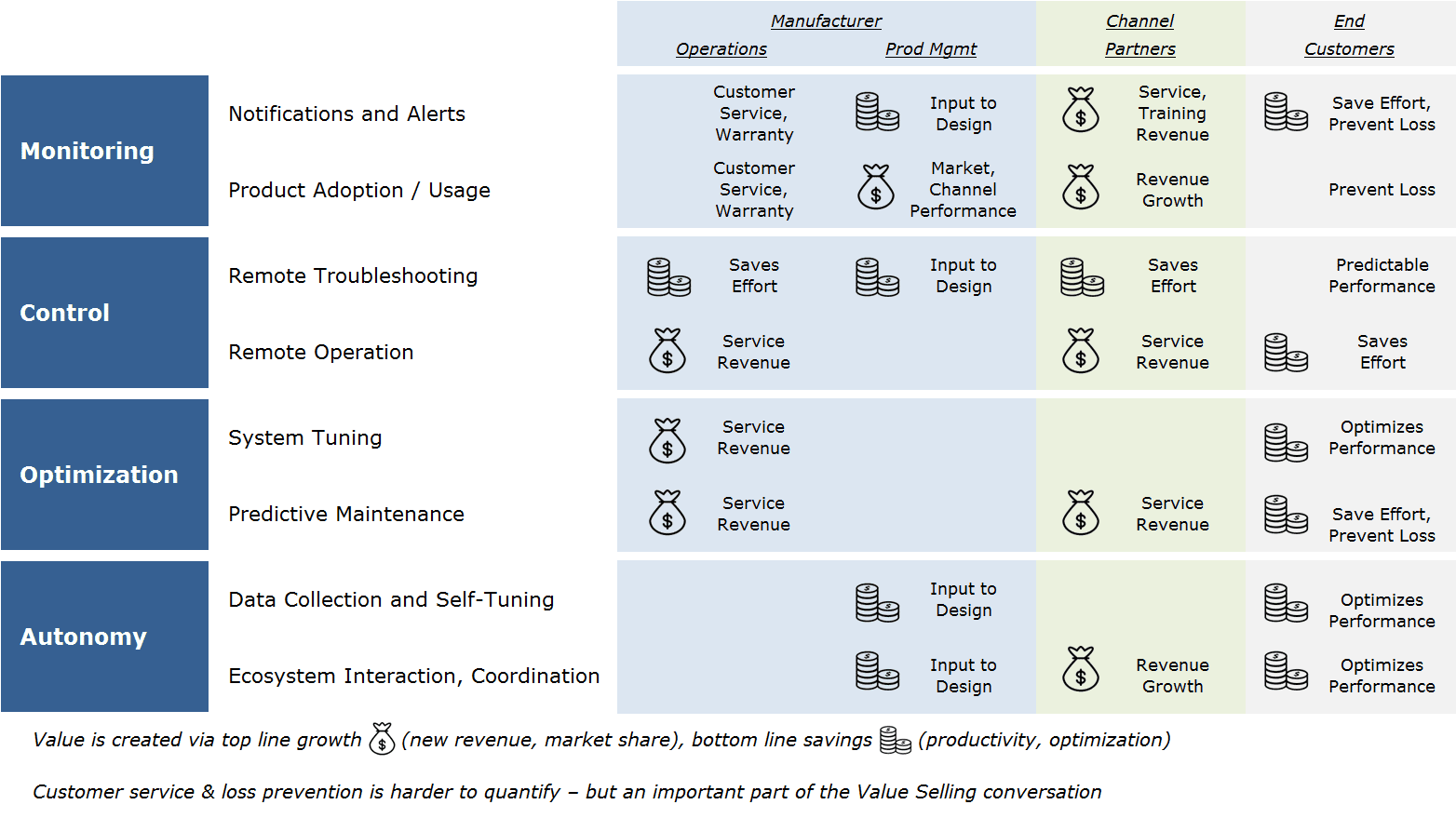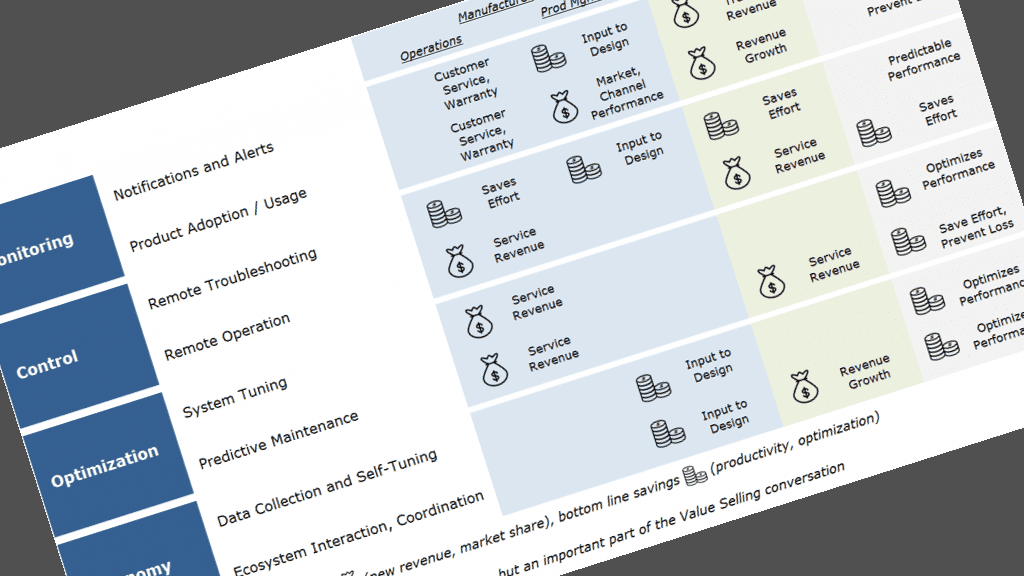A practical method for zeroing in on where value is created by digital products and services; it depends a lot on the Value Chain (how products eventually get to the End Customer).
Note: This is the original version of this article – the updated version can be found here.
When introducing the idea of Smart, Connected Products (a.k.a. the Internet of Things, or IoT), a critical early conversation is about creating value. The focus will be different, based on who you’re talking with; with a product manager, you’re talking about how much revenue can be generated. The CEO and the Board, on the other hand, will want to hear about creating value from a broader perspective, including the entire chain of connections between yourself and your end customers. Value can be created in a number of different places, and a holistic understanding of this could shed a different light on your overall digital strategy.
The Customer Value Chain
We define the Customer Value Chain as macro steps in between the manufacturer and the end customer – multiple participants will be able to derive value from information added to our products. The Customer Value Chain will differ based on your specific path to the ultimate buyer – for this exercise, we’ll keep it fairly simple; a product manufacturer, selling to a distribution channel, with limited direct contact to the ultimate end user. (Yes, I know this is an oversimplification of Porter’s value chain. We are trying to illustrate some high concept here; a little poetic license to make your point is always permitted.)
Note that channel partners are a critical part of the conversation – and are often the complicating factor that slow down disruptive change, since there is a common (and very legitimate) fear of disintermediation – or, at the very least, an upset to the delicate balance of forces that has evolved over the years.
IoT Use Cases
Next, let’s think about potential use cases – how might we add IoT technology to our products? What features and functionality will we be adding? Again, we’re borrowing from Porter here; the rows in the table represent the hierarchy of functionality outlined in his first Smart, Connected Products article. I have bulleted out some typical applications for Things that want to connect to the Internet – stated broadly enough that they cover most IoT ideas.

Where’s The Beef?
We are primarily interested in creating value that is clearly quantifiable. To keep the discussion simple, we will classify value creation as top line growth (ex. new revenue, increased market share) versus bottom-line savings (ex. labor productivity, asset optimization, cost-cutting).
You may find it worthwhile to call out value creation that is a bit harder to quantify; ideas like “better customer service” (which can lead to top line growth and/or customer retention), or “loss prevention” (risk reduction, an indirect benefit that is often hard to quantify). This really depends on the audience; when arguing for capital, hard benefits are preferred – but when having a value-selling conversation, or evaluating the strategic impact, these indirect and “soft” benefits can be valuable.
Filling Out the Grid
Now it’s just an exercise of thinking through each of these use cases and the impact on each part of the Customer Value Chain. Let’s walk through the first row; how do features like real-time monitoring and automated notifications impact each of the links? Working backwards …
- When our Smart, Connected Products are letting the end customer know if and when maintenance is required, they generate bottom-line savings by avoiding service that is not required, and eliminate unplanned downtime (preventing loss) with an early warning system that predicts bad things before they happen.
- Our channel partners are the one that get the service and training revenue, and Smart, Connected Products that actively monitor themselves will help make sure that required service is performed. These Things might also let us know when the operator is not using the device correctly – a nice justification for incremental training. And of course since this information is a new and differentiating feature in the market, the dealer channel will see incremental sales due to growing share as smart, connected products are preferred over their unconnected competition.
- There is plenty of value for the manufacturer as well. In addition to incremental revenue for unit sales, the product management team will benefit; engineering will see live data from devices in the field, and develop a deeper understanding of operational characteristics and areas for improvement (including, perhaps, areas to take cost out of overengineered products). And channel management folks will be able to quantify things like product pull-through and territory saturation.
There is a story to be told for every row in the grid – it frames the conversation, so marketing & engineering teams can add a wee bit of structure to your brainstorming.
Where’s Your Value?
Note that the structure of your Customer Value Chain – the ultimate path to your customer – can have a significant impact on this conversation. I’ve walked through this exercise with many businesses, and each is a little different. For example – a distributor once engaged me in conversation on how they might benefit from Smart, Connected Products at their customer sites. They had some great ideas – but thought they were “just the middleman”, with no leverage to turn on their information flows.
How to get the OEM to participate? Understanding that value chain, and the different places that value could be created, helped us brainstorm a couple of breakthrough ideas … and their efforts to “change their world” are slowly, but deliberately, moving forward.
Can you apply the Customer Value Chain approach for your organization? Let me know in the comments below …
Money Bag by icon 54 from the Noun Project
Money Coins by Iconographer from the Noun Project
10 April, 2016






Comments (0)